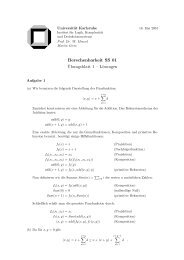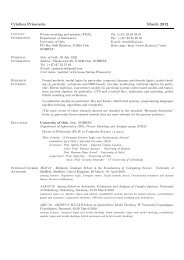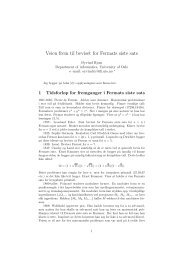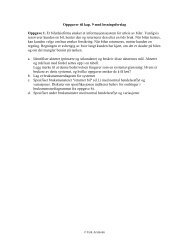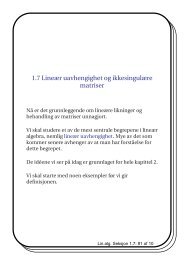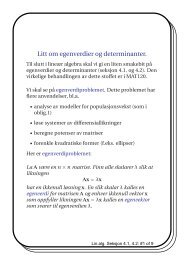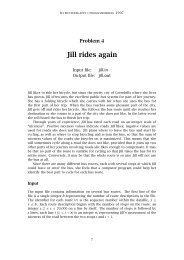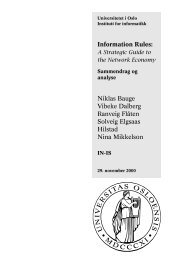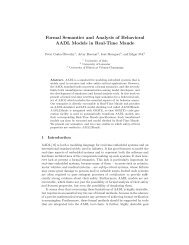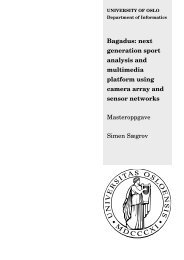Timed CTL Model Checking in Real-Time Maude⋆ - IfI
Timed CTL Model Checking in Real-Time Maude⋆ - IfI
Timed CTL Model Checking in Real-Time Maude⋆ - IfI
Create successful ePaper yourself
Turn your PDF publications into a flip-book with our unique Google optimized e-Paper software.
<strong><strong>Time</strong>d</strong> <strong>CTL</strong> <strong>Model</strong> <strong>Check<strong>in</strong>g</strong> <strong>in</strong> <strong>Real</strong>-<strong>Time</strong> Maude 27<br />
Then dπ′ j ′ is <strong>in</strong> π0 <strong>in</strong> an <strong>in</strong>terval (n¯r, (n + 1)¯r) for some n ∈ N0. Furthermore<br />
there is another state tmid at time po<strong>in</strong>t n¯r + ¯r/2 and <strong>in</strong>dex n0 + j ′′ <strong>in</strong> π0.<br />
Aga<strong>in</strong> by Lemma 1 we have T K, tπ′ j ′′ |=c ϕ2.<br />
Now we can build a time abstraction of π ′ which we obta<strong>in</strong> by replac<strong>in</strong>g each<br />
rl<br />
tick step sequence tl −→ . . . rl+i−1<br />
−→ tl+i with dπ′ l = n¯r/2 and dπ′<br />
l+i = (n+1)¯r/2<br />
r<br />
for some n ∈ N0 by tl −→ tl+i with r = l+i−1 ri.<br />
This time abstraction π ′′ is a path of T K gcd , and the states of π ′′ appear<br />
at the same time po<strong>in</strong>ts also <strong>in</strong> π ′ . Furthermore, s<strong>in</strong>ce dπ′ j ′′ is a multiple of<br />
¯r/2, it also appears <strong>in</strong> π ′′ at some position j ′′′ . F<strong>in</strong>ally, s<strong>in</strong>ce all states <strong>in</strong> π ′<br />
with <strong>in</strong>dex less that j ′′ satisfy ϕ1, also all states <strong>in</strong> π ′′ with <strong>in</strong>dex less that<br />
j ′′′ , build<strong>in</strong>g a subset of the previous ones, satisfy ϕ1. Thus π ′′ satisfies the<br />
bounded until path formula, i.e., T K gcd , t |=p E ϕ1 UI ϕ2.<br />
– ϕ = A ϕ1 UI ϕ2: We need to show both implication directions.<br />
“⇐”: Assume that T K gcd , t |=p A ϕ1 UI ϕ2. By def<strong>in</strong>ition<br />
T K gcd , t |=p A ϕ1 UI ϕ2 iff for each π ∈ tfPathsT Kgcd(t) there is an <strong>in</strong>dex j s.t. dπ j ∈ I,<br />
i=l<br />
T K gcd , t π j |=p ϕ2 and ∀ 0 ≤ i < j T K gcd , t π i |=p ϕ1.<br />
In order to prove that T K, t |=c A ϕ1 UI ϕ2, we have to show that for each<br />
path π ∈ tfPathsT K(t) there exists a time ref<strong>in</strong>ement π ′ ∈ tfPathsT K(t) of π<br />
and an <strong>in</strong>dex j s.t. dπ′ j ∈ I, T K, tπ′ j |=c ϕ2, and ∀ 0 ≤ i < j T K, tπ′ i |=c ϕ1.<br />
Let π ∈ tfPathsT K(t) and let π ′ ∈ tfPathsT K(t) be a ref<strong>in</strong>ement of π conta<strong>in</strong><strong>in</strong>g<br />
a state at each time po<strong>in</strong>t n¯r/2, n ∈ N0.<br />
We obta<strong>in</strong> π ′′ from π ′ rl<br />
by replac<strong>in</strong>g each tick step sequence tl −→ . . . rl+i−1<br />
−→<br />
r<br />
−→ tl+i<br />
tl+i with d π′<br />
l<br />
with r = l+i−1<br />
i=l<br />
= n¯r/2 and dπ′<br />
l+i = (n + 1)¯r/2 for some n ∈ N0 by tl<br />
ri.<br />
Note that π ′′ is <strong>in</strong> tfPaths T K gcd(t) and thus by assumption there is an <strong>in</strong>dex<br />
j such that d π j ∈ I, T Kgcd , t π j |=p ϕ2 and T K gcd , t π i |=p ϕ1 for all 0 ≤ i < j.<br />
Let j be such an <strong>in</strong>dex.<br />
Then by construction and <strong>in</strong>duction there exists an <strong>in</strong>dex j ′ such that dπ′ j ′ is<br />
a multiple of ¯r/2, dπ′ j ′ ∈ I, T K, tπ′ j ′ |=c ϕ2 and T K, tπ′ i |=c ϕ1 for all 0 ≤ i < j ′<br />
with d π′<br />
i<br />
be<strong>in</strong>g a multiple of ¯r/2. For the other states prior to the <strong>in</strong>dex j′<br />
we construct π0 as the composition of π pre and π ′ . Note that <strong>in</strong> each <strong>in</strong>terval<br />
(n¯r, (n + 1)¯r) with (n + 1)¯r < tπ′ j ′ there is a po<strong>in</strong>t at n¯r + ¯r/2, for which<br />
we have already shown to satisfy ϕ1. Thus by Lemma 1 also the states that<br />
are prior to the <strong>in</strong>dex j ′′ and are not at multiples of ¯r/2 satisfy ϕ1. Hence<br />
π ′ |=c ϕ.<br />
“⇒”: Assume T K, t |=c A ϕ1 UI ϕ2.<br />
T K, t |=c A ϕ1 UI ϕ2 iff for each path π ∈ tfPathsT K(t) there is a time<br />
ref<strong>in</strong>ement π ′ ∈ tfPathsT K(t) of π<br />
and an <strong>in</strong>dex j s.t. dπ′ j ∈ I,<br />
T K, tπ′ j |=c ϕ2, and ∀ 0 ≤ i < j T K, tπ′ i |=c ϕ1.



